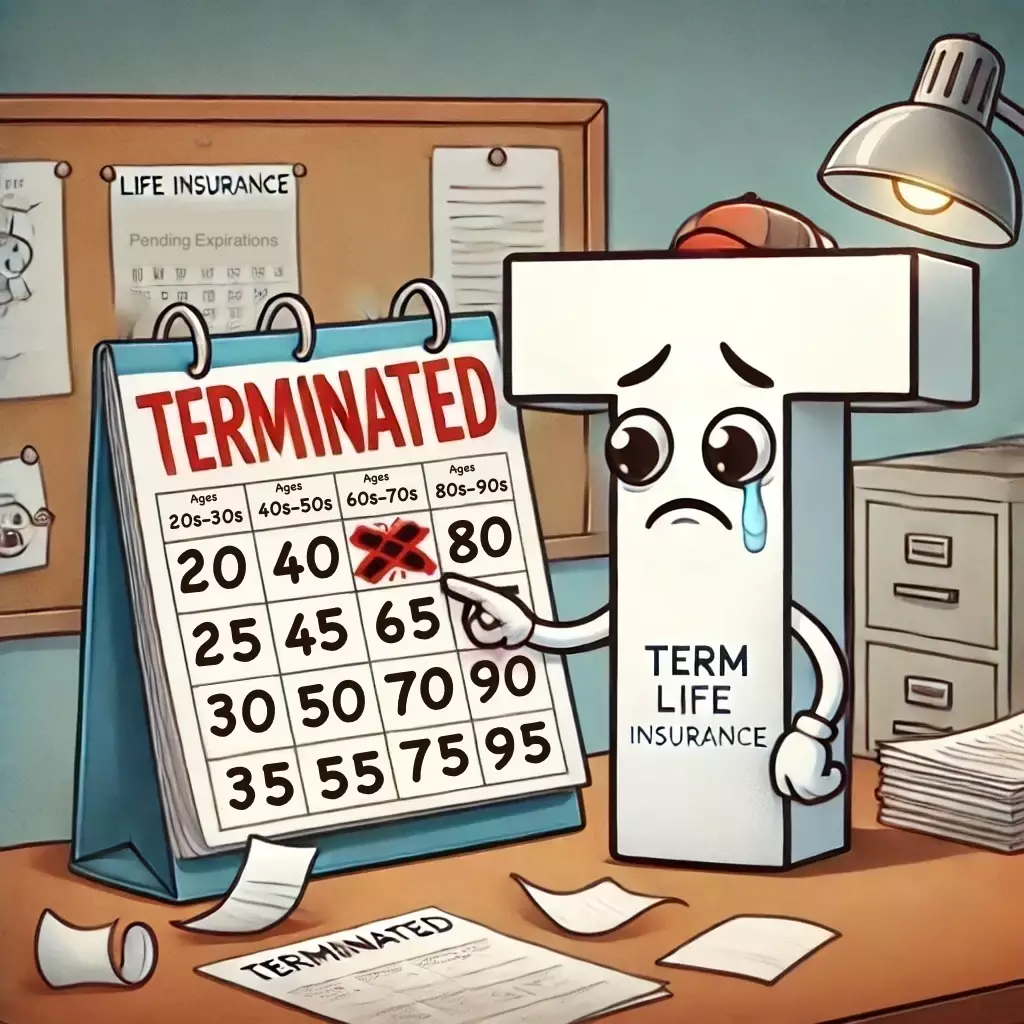What Type of Life Insurance is Best? Whole Life versus Term Life
Published July 08, 2024 | Updated July 17, 2024

Life insurance is a financial product designed to protect your loved ones financially in the event of your death. It provides a death benefit, which is typically a lump-sum payment to your designated beneficiaries. This benefit can be used to replace lost income, pay off debts, cover funeral expenses, and more, ensuring that your family remains financially secure during a difficult time.
Types of Life Insurance
When considering life insurance options, understanding the differences between term and whole life insurance is crucial. Term life insurance offers affordable, temporary coverage, while whole life insurance provides lifelong protection with a cash value component, offering financial flexibility and some investment benefits.
Term Life Insurance (Temporary Life Insurance Coverage)
Term life insurance offers coverage for a specified period, usually ranging from 10 to 30 years. A term life insurance policy provides a guaranteed death benefit, after any applicable waiting periods, for the duration of the policy term, ensuring financial protection during the years when beneficiaries might depend on the policyholder’s income, such as when children are young or a mortgage is still being paid off. Term life insurance policies generally have lower premiums compared to whole life insurance, making them an attractive option for those seeking affordable coverage. Most employer-provided life insurance plans (also known as Group Life or Employer-Sponsored Life Insurance) are term policies, expiring when the employee leaves employment or reaches retirement age, whichever comes sooner.
Whole Life Insurance (Permanent Life Insurance Coverage)
Whole life insurance, also known as a whole life insurance policy, provides lifelong coverage as long as premiums are paid. One of its distinguishing features is the cash value component that grows over time, which policyholders can borrow against or withdraw. Whole life insurance premiums are typically higher than those for term life insurance, but the policy offers the dual benefits of a death benefit and cash value accumulation. The cash value in a whole life insurance policy can serve as an investment feature, growing tax-deferred and providing financial flexibility (this is not tax advise, so always consult a tax advisor).
Life Insurance Policy Comparison of Costs and Features
When comparing costs, term life insurance is often less expensive, especially for younger policyholders. However, the older you are when you apply for either term or whole life insurance, the higher the premium will likely be, which is why it’s important to apply early and not wait. Whole life insurance premiums generally start higher than term premiums because whole life covers the insured for their entire lifetime and includes a cash value component. Unlike term insurance premiums, which can increase over time, whole life premiums are typically locked in at the time of application and do not rise with age.
Key Benefits and Features
-
Term Life Insurance: When comparing term life insurance vs whole life insurance, term life insurance provides coverage for a specific period, typically with lower premiums.
-
Whole Life Insurance: Offers lifelong coverage and includes a cash value component that can grow over time. Whole life policies may also offer dividend payments, which can be reinvested or used to reduce premiums.
Choosing the Right Insurance
When choosing between term and whole life insurance, consider factors such as your age, health, family’s financial needs, and long-term financial goals. Assess how life insurance fits into your overall financial plan and whether you need temporary coverage or lifelong protection. Universal life insurance is another option that offers variable premiums and lifelong coverage. Universal life insurance can be harder to qualify for than a standard whole life insurance policy and typically involves a medical exam unlike most final expense whole life policies.
Factors to Consider:
-
Age and Health: Younger and healthier individuals may get lower premiums, and individuals with pre-existing conditions may find it easier to qualify for whole life rather than term life coverage.
-
Financial Needs: Determine the amount of coverage needed to support your family, cover your arrangement preferences (burial vs. cremation), and pay for any remaining final expenses like outstanding debts.
-
Long-term Goals: Decide whether you need temporary or permanent coverage to align the type of life insurance policy you choose with your financial objectives.
Who Should Choose Term Life Insurance
-
Those looking for a cheap, cost-effective insurance option
-
Individuals who need coverage for a specific period, like until children are financially independent or a home is paid off (mortgage protection insurance)
-
Those not concerned with cash value flexibility
Who Should Choose Whole Life Insurance
-
Individuals who want lifelong coverage, especially for final expense like funeral costs such as cremation or burial expenses
-
Individuals on a fixed income or wanting flat, monthly premiums
-
Policyholders seeking to build guaranteed cash value for financial flexibility
The Optimal Coverage Choice for Seniors and Final Expense Planning

Whole life insurance emerges as the superior choice for seniors, especially when financially planning for the inevitable. Unlike term insurance, which may expire at a critical time when insurance is most needed, whole life insurance assures coverage until the end of one’s life, ensuring that beneficiaries receive a death benefit no matter when the policyholder passes away. This permanence is particularly crucial for seniors who may face difficulties in renewing or obtaining new insurance later in life due to age or health issues.
Additionally, the cash value that accumulates within a whole life policy can serve multiple purposes. It can be used to cover unforeseen financial needs, such as medical bills, or even to pay the policy premiums, thereby relieving financial pressure during retirement years. Importantly, this built-in financial safety net offers peace of mind to policyholders and their families, knowing that final expenses such as funeral costs, debts, and other end-of-life expenses will be covered without burdening loved ones.
How to Structure Your Beneficiaries
A life insurance beneficiary is the designated person or persons who receives the death benefit, which is typically tax-free and bypasses probate, ensuring timely financial support (consult a tax advisor and/or probate attorney for specifics). There are two primary beneficiary types:
- Primary Beneficiaries
- Contingent Beneficiaries
Primary vs. Contingent Beneficiaries
When setting up a life insurance policy, it’s important to structure your beneficiaries correctly. A primary beneficiary is the person or entity designated to receive the death benefit first. If the primary beneficiary is unable or unwilling to receive the benefit, a contingent beneficiary (also known as a secondary beneficiary) will receive the proceeds. Naming contingent beneficiaries ensures that the death benefit will be distributed according to your wishes, even if the primary beneficiaries predecease the insured.
Choosing One Primary Beneficiary
Ideally, declare only one primary beneficiary for your life insurance policy. This simplifies the claims process by requiring the insurance company to verify only one individual, speeding up documentation and approval.
A single primary beneficiary reduces administrative burden and delays, ensuring a quicker payout. It also minimizes disputes or confusion, providing an efficient transition of funds to support your loved one during a difficult time.
To cover all bases, also declare at least one contingent beneficiary. This ensures your life insurance proceeds go to your loved ones, offering financial security and honoring your intentions regardless of circumstances.
Having both primary and contingent beneficiaries provides comprehensive coverage and clarity in distributing your policy benefits. Properly designating beneficiaries avoids complications and ensures your life insurance proceeds are distributed according to your wishes.
How the Cause of Death Can Impact Life Insurance Payouts
When it comes to life insurance policies, the cause of death can significantly impact the payout beneficiaries receive.
Death Due to Natural Causes
Natural causes, like illness or aging, are covered by most life insurance policies, providing full death benefits. Suicide is treated differently; most policies exclude coverage within the first two years. If suicide occurs during this period, premiums may be refunded, but no benefits are paid, protecting insurers from misuse.
Death Due to Accident
Accidental death, resulting from unexpected events like car accidents, falls, or other unforeseen incidents, may result in an additional payout depending on the policy. Some policies may offer other benefits, which may include a payout on top of the standard death benefit if the policyholder dies or suffers severe injury due to an accident.
Additional Features and Riders

Many life insurance policies offer riders or include additional benefits that provide extra coverage in specific situations. A life insurance rider is an optional add-on to a standard life insurance policy that provides added benefits or coverage tailored to meet specific needs of the policyholder. Riders allow for customization of a policy, enabling individuals to enhance their coverage without purchasing a separate policy.
Accidental Death and Dismemberment Protection
One common rider is Accidental Death and Dismemberment (AD&D) protection. This rider pays an additional benefit if the insured dies or suffers severe injuries as a result of an accident. It’s designed to provide extra financial support in cases where an unexpected accident leads to death or dismemberment, offering an added layer of security. Some AD&D riders, like riders offered through Heritage Associates, even include reimbursement for transport of mortal remains in the event death occurs while traveling away from home.
Child Riders
Another popular rider is the child rider, which provides life insurance coverage for the policyholder’s children. This rider typically offers a small death benefit if a covered child passes away. Child riders are an affordable way to extend life insurance protection to all members of the family, ensuring that funeral expenses or other costs associated with a child’s death are covered without causing financial strain.
Terminal Illness Benefits / Accelerated Death Benefits
Terminal illness benefits, also known as accelerated death benefits, are another crucial feature available in many life insurance policies. This rider allows policyholders diagnosed with a terminal illness to access a portion of their death benefit while still alive. The funds can be used to cover medical expenses, pay for hospice care, or address other financial needs that arise due to the illness. This feature provides significant financial relief and peace of mind during challenging times.
7 Key Takeaway Questions to Ask When Shopping for Life Insurance Policies
When shopping for life insurance, be sure to understand the policy type and coverage details. If you have already purchased a policy, take advantage of the free look period (typically 30 days) that insurers are required to provide. This period allows you to review the policy benefits thoroughly and compare other plans while still being entitled to a full refund. In summary, remember to ask these seven key questions before making your final decision on a life insurance policy:
1. Is coverage whole life or term life?
Understanding the policy type—whether it is whole life or term life insurance—is crucial when shopping for life insurance because it directly impacts your long-term financial planning, coverage duration, and overall cost. Term life insurance is suitable for those seeking temporary coverage for a specific period, such as until children are grown or a mortgage is paid off. It usually has lower premiums, making it more affordable, but it offers no cash value and expires at the end of the term, potentially leaving you without coverage when you may need it most.
In contrast, whole life insurance provides permanent coverage that lasts your entire life as long as premiums are paid. This type of policy not only ensures a death benefit regardless of when you pass away but also builds cash value over time, which can be borrowed against or withdrawn. Whole life insurance typically comes with higher premiums, but the added benefits and lifelong security can be worth the extra premium, especially for those looking to provide lasting financial support to their beneficiaries.
Key terminology to use when inquiring whether a policy is whole life or term life insurance

When inquiring whether a policy is whole life or term life, it’s helpful to use specific terms and memory cues to clarify your understanding.
Start by asking if the policy has an expiration date or if it terminates after a certain number of years. If the policy is described as temporary coverage that ends at a certain age, like age 65, 80, or 90, or after a set term, typically 10, 20, or 30 years, it is likely a term life policy. Use the memory cue that “T” stands for terminates or temporary to remember that term life insurance is not permanent.
When verifying whole life insurance, ask if the policy provides permanent coverage that lasts your entire life, without expiration, as long as premiums are paid. Remember, whole life policies are designed to last your “whole life,” offering lifelong protection with cash value accrual and flexibility.
By focusing on these key characteristics and using these memory aids, you can easily distinguish between term life and whole life insurance policies.
2. Will premiums change or increase over time?
Be sure to ask if the premiums increase over time or at certain ages. Start by asking the insurance provider if the premiums are fixed or if they can change as you age.
If the premiums can increase at specific intervals, such as every 2 to 5 years, or as you reach certain age milestones, this indicates a term life policy, as these policies often have lower initial premiums that escalate over time to reflect the increased risk as you age (variable premiums).
In contrast, whole life insurance premiums remain level and fixed for the duration of the policyholder’s life. If the premiums are guaranteed to stay the same throughout the life of the policy with no expiration of benefits and cash value accrual, you are likely dealing with a whole life policy.
Understanding this key difference can help you make an informed decision and select a policy that fits your long-term financial plans and stability.
3. Is there a waiting period?
When shopping for life insurance, it is essential to understand when the coverage will take effect. Some policies have a waiting period of 2-3 years before full coverage begins, meaning that if the policyholder passes away during this period, the beneficiaries may not receive the full death benefit. Conversely, some companies, like those represented by Heritage Associates, offer immediate, day-one coverage with no waiting period, ensuring that beneficiaries are protected from the start. Understanding the waiting period can help you choose a policy that meets your immediate coverage needs.
4. How Long Does It Take for Coverage to Payout?
The time it takes for a life insurance policy to pay out after death occurs can vary significantly between companies. Some insurers are known for their quick processing times and can pay out benefits within 24 hours of receiving a claim, while others may take several months to process the payout. It’s important to ask about the claim filing process and typical payout times to ensure that your beneficiaries will not face undue financial stress during a difficult time.
Standard requirements when filing a claim
Filing a life insurance claim typically requires several key documents. The most crucial document is the death certificate, which officially confirms the policyholder’s death. Beneficiaries will also need to complete a claim form provided by the insurance company. Additional documentation may include proof of the beneficiary’s identity and any other documents requested by the insurer to process the claim. Understanding the claim requirements can help streamline the process and ensure timely receipt of the death benefit.
5. Will the Policy Pay for Death Due to Natural Causes and Accidents?
To determine if coverage is accident-only or true life insurance, ask the provider if the policy covers all causes of death, including natural causes like illness and aging, or if it’s limited to accidental deaths. Clarify the death benefit scope and inquire about any exclusions or limitations. This helps differentiate between accident-only policies, which cover only accidental deaths, and true life insurance, offering broader protection.
6. What other benefits or riders are available with the coverage?
When shopping for life insurance policies, ask about additional benefits or riders included with coverage. It’s important to inquire if AD&D or child riders are available, as well as any terminal illness or accelerated death benefits.
Instead of focusing solely on premium rates, consider all the benefits a policy offers. This way, your analysis accounts for all benefits gained per premium dollar paid. Cheap premiums often result in limited benefits, which could adversely impact you or your loved ones when coverage is needed most.
Some policies, like those from Heritage Associates, include additional support services for funeral or cremation planning. For example, Funeral Advantage policies provide a free membership to the Funeral Consumer Guardian Society, which assists in planning, negotiating, and carrying out the policyholder’s final wishes.
7. What is the financial rating and security of the insurance company?
Evaluating the financial rating and stability of insurance companies is crucial when purchasing life insurance. Financial health determines an insurer’s ability to pay claims reliably. Companies with high ratings are more likely to fulfill obligations, ensuring beneficiaries receive death benefits as expected. Poor financial stability risks non-payment or delayed claims. Consult resources like A.M. Best, Standard & Poor’s, Moody’s, Fitch Ratings, and the Better Business Bureau for detailed assessments of insurers’ financial strength and customer satisfaction, helping you select a reliable provider.
Understanding these differences can help you make an informed decision about which type of life insurance best suits your needs and financial situation. Consider applying for life insurance through a life insurance company to find a financial professional who can provide information about different options for life insurance policies.
Frequently Asked Questions
- Duration of Coverage:
- Term Life Insurance: Provides coverage for a specific period (e.g., 10, 20, or 30 years). The policy expires at the end of the term, and no benefits are paid if the policyholder outlives the term.
- Whole Life Insurance: Offers lifelong coverage as long as premiums are paid. The policy remains in force until the policyholder’s death, guaranteeing a death benefit payout.
- Premium Variability:
- Term Life Insurance: Premiums are usually lower than those for whole life insurance, but premiums often increase over time. For example, it's very common for premiums to increase every 2-5 years, so if your premiums have changed, you likely have a term life insurance policy.
- Whole Life Insurance: Has higher premiums that remain level and never change for the policyholder’s entire life. Some whole life policies even have the ability to become paid up after a certain number of years like 20 years, meaning no further premiums are owed after the paid-up date, but coverage continues and remains in force for life. Ask about a 20-Pay solution by applying for 20-Pay life insurance today!
- Cash Value Component:
- Term Life Insurance: Does not accumulate cash value. It is purely a death benefit policy.
- Whole Life Insurance: Includes a cash value component that grows over time. The policyholder can borrow against or withdraw this cash value.
- Policy Expiration:
- Term Life Insurance: Expires at the end of the term. If additional coverage is needed, the policyholder must renew or purchase a new policy, which can be more expensive due to increased age or health issues.
- Whole Life Insurance: Does not expire as long as premiums are paid. Provides a death benefit regardless of when the policyholder dies.
- Investment Component:
- Term Life Insurance: No investment component; it is designed solely for coverage.
- Whole Life Insurance: Acts as an investment vehicle with the cash value component growing tax-deferred over time. Some policies may also pay dividends.
If a life insurance company becomes insolvent, state insurance departments and guaranty associations protect policyholders. These associations, funded by assessments on other insurers, cover claims up to a state-specified limit. A solvent insurer may take over policies, ensuring coverage continuity. These measures aim to minimize financial impact and provide security. While policyholders may experience some delays and potential modifications in their policies, these protective measures aim to minimize the financial impact and provide a degree of security in an otherwise uncertain situation.
Reinsurance: A Safety Net for Insurers
Reinsurance stabilizes the insurance industry by allowing insurers to mitigate large claims' risks by purchasing insurance from other insurers. This distributes risk evenly, preventing any single company from being overwhelmed and protecting financial health. Reinsurers offer crucial financial backing during catastrophic losses, enhancing the primary insurers' resilience and stability.
Statistics on Insolvency
The insolvency of life insurance companies is relatively rare, thanks to stringent regulatory oversight and the protective measures in place. According to data from the National Organization of Life and Health Insurance Guaranty Associations (NOLHGA), fewer than 1% of life insurance companies become insolvent over a decade. This low rate underscores the effectiveness of the regulatory frameworks and financial safeguards designed to protect policyholders.
The Importance of Assessing Financial Strength
Assessing an insurance company's financial strength is crucial for ensuring reliable claim payouts. As previously discussed, the financial health of an insurer ensures its ability to pay out claims promptly and reliably over the long term. Choosing a highly rated insurance company minimizes the risk of insolvency and ensures that your beneficiaries will receive the support they need when it matters most.
Converting a term life policy involves changing it to whole or permanent life insurance, offering lifelong protection without a new medical exam. Partial conversions are sometimes possible, allowing a portion of term coverage to be converted. This requires a request form and premium adjustment.
Not all term policies offer conversion options; availability depends on the original policy terms. Policyholders should review their contract or consult their insurer to understand their options, costs, and benefits.
If conversion isn't possible, applying for a new whole life policy is an alternative. Some insurers offer simplified underwriting with fewer health questions and no exam. Ensure your coverage aligns with long-term financial goals and desired benefits.
Insure peace of mind and get qualified for life insurance coverage today!